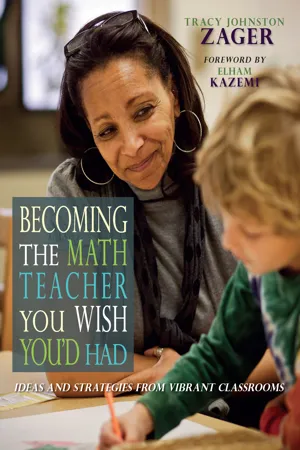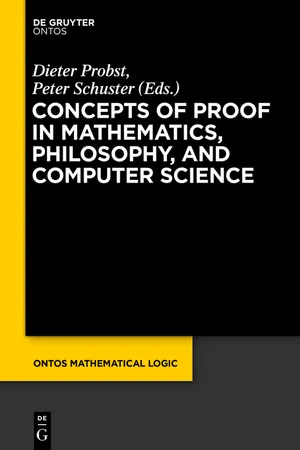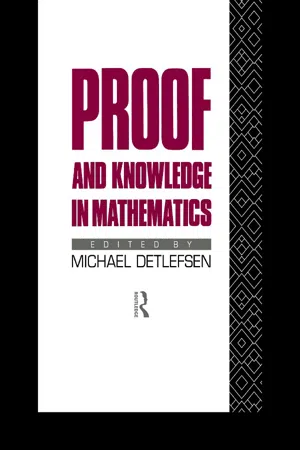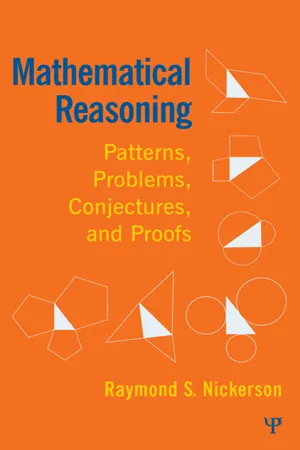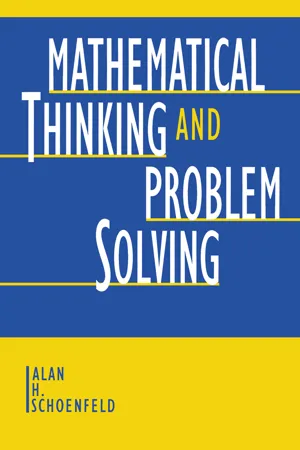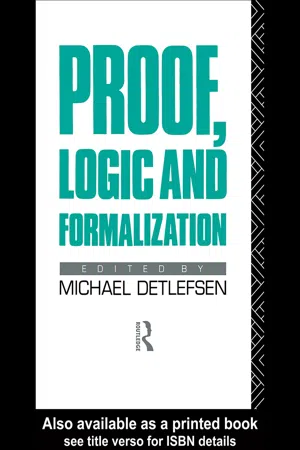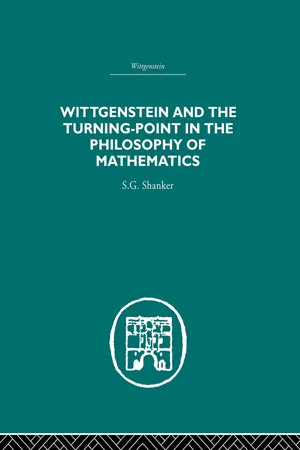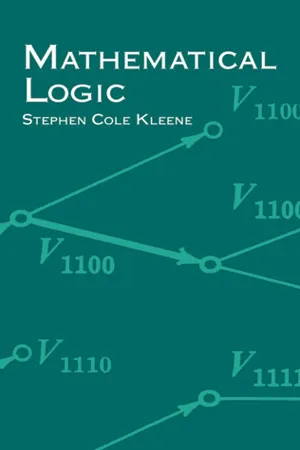Mathematics
Proof
In mathematics, a proof is a logical argument that demonstrates the truth of a statement or theorem. It typically involves a series of steps that follow established rules of logic and reasoning, leading to a clear and irrefutable conclusion. Proofs are essential in establishing the validity of mathematical results and are a fundamental aspect of mathematical reasoning and understanding.
Written by Perlego with AI-assistance
Related key terms
9 Key excerpts on "Proof"
- eBook - ePub
Becoming the Math Teacher You Wish You'd Had
Ideas and Strategies from Vibrant Classrooms
- Tracy Johnston Zager(Author)
- 2023(Publication Date)
- Routledge(Publisher)
11 Mathematicians ProveDOI: 10.4324/9781032680637-11A Proof should be an epiphany from the gods, not a coded message from the Pentagon.—Paul Lockhart, A Mathematician’s LamentWhat Is Proof?
Proof has multiple meanings to mathematicians, and those meanings have evolved over time. The most formal usages emphasize objective, airtight, written arguments in which each step follows logically from the one before it, yielding deductive certainty. While modern mathematicians certainly strive for flawless arguments, many have pushed back against traditional, formal definitions, arguing they are reductive and do not convey the essence, experience, or reality of what mathematicians do. For example, Ian Stewart wrote:After wondering about a richer, fuller description, Stewart decided on this one:A Proof, they tell us, is a finite sequence of logical deductions that begins with either axioms or previously proved results and leads to a conclusion, known as a theorem ... This definition of “Proof” is all very well, but it is rather like defining a symphony as “a sequence of notes of varying pitch and duration, beginning with the first note and ending with the last.” Something is missing. Moreover, hardly anybody ever writes a Proof the way the logic books describe. (2006, 89)Oxford mathematician Marcus du Sautoy explained Proofs using a different analogy, but with a similarly enticing description of the audience’s experience:A Proof is a story. It is a story told by mathematicians to mathematicians, expressed in their common language ... If a Proof is a story, then a memorable Proof must tell a ripping yarn ... When I can really feel the power of a mathematical storyline, something happens in my mind that I can never forget. (2006, 89-94)A successful Proof is like a set of signposts that allow all subsequent mathematicians to make the same journey. Readers of the Proof will experience the same exciting realization as its author that this path allows them to reach the distant peak. Very often a Proof will not seek to dot every i and cross every t, just as a story does not present every detail of a character’s life. It is a description of the journey and not necessarily the re-enactment of every step. The arguments that mathematicians provide as Proofs are designed to create a rush in the mind of the reader. (2015) - Dieter Probst, Peter Schuster(Authors)
- 2016(Publication Date)
- De Gruyter(Publisher)
Proofs play an important role in mathematics and its methodology (in the context of justification). They form the main method of justifying mathematical statements. Only statements that have been proved can be treated as belonging to the corpus of mathematical knowledge. Proofs are used to convince the readers of the truth of presented theorems. But what is in fact a Proof? In mathematical research practice Proof is a sequence of arguments that should show the truth of the claim. Of course the particular arguments used in a Proof depend on the situation, on the audience, on the type of a claim, etc. Hence a concept of a Proof has in fact a cultural, psychological and historical character. In practice mathematicians generally agree whether a given argumentation is or is not a Proof. More difficult is the task to define a Proof as such. Beside Proofs used in the research practice there is a concept of a formal Proof developed by logic. What are the relations between them? What roles do they play in mathematics?Problems of that type will be considered in the paper. We start (Section 1) by some historical remarks showing in what circumstance the idea of a Proof (informal and formal) appeared. Next (Section 2) the features and role played by informal Proofs will be considered. The subject of Section 3 will be formal Proofs andtheir relation to the concept of truth. In the closing Section 4 some conclusions will be made and a thesis (similar to Church-Turing Thesis in the computation theory) formulated.2Historical remarks
The model of mathematics as a science, its paradigm functioning in fact till today was formulated and developed in the ancient Greece about the 4th century B.C. Earlier, for example in ancient Egypt or Babylon mathematics consisted of practical procedures that should help to solve everyday problems such as measuring surface area or the amount of cereal in a granary or oil in a jug. In those both pre-Greek mathematics – though they were advanced and sophisticated (especially the Babylonian mathematics) – there was no need to prove statements. In fact there were no general statements and no attempts were undertaken to deduce the results or to explain their validity. One was satisfied by instructions what should be done in order to receive the result or to perform the required task. In fact mathematics there was a collection of separate algorithms (as one would say today) and resembled in certain sense informatics (though without sophisticated technical equipment). Similar was the situation in China –- eBook - ePub
Proofs 101
An Introduction to Formal Mathematics
- Joseph Kirtland(Author)
- 2020(Publication Date)
- Chapman and Hall/CRC(Publisher)
2Proof Techniques
A Proof shows that a mathematical statement is true. Documenting mathematical observations has a long and rich history.2.1 INTRODUCTION- A bone found in Africa, dating to 9000–6500 BCE, contains notches arranged in groups, perhaps indicating arithmetic observations.
- It is theorized that integers written on Babylonian cuneiform tablets were arranged according to mathematical properties.
- Computational exercises found on the Rhind papyrus written by the Egyptians indicate that mathematics had established properties to be learned and practiced.
- Greek mathematicians embraced the idea that all statements needed to be formally justified. Most notable is the work Elements, a series of 13 books written by Euclid (see [Hea02] ), where he rigorously proved results in geometry and other areas.
Before we start writing Proofs, the framework of modern mathematics needs to be established. However, if you are interested in the history and evolution of mathematics, I suggest [GG98] and [FG87] .2.2 AXIOMATIC AND RIGOROUS NATURE OF MATHEMATICSTo demonstrate the modern axiomatic nature of mathematics, we will reflect upon the work you did in geometry. In general, any investigation begins by settling on the undefined terms. These are the words or phrases whose meaning everyone agrees to without explanation. In geometry, the terms point, line, on (in the sense that a point is on a line), and plane are accepted as undefined terms.The next step is to identify the properties, called axioms or postulates - eBook - ePub
- Michael Detlefsen(Author)
- 2005(Publication Date)
- Routledge(Publisher)
practice of proving mathematical statements evolve?That is a good question too, and answering it will take us a large way towards answering the two questions I posed above. However, from my realist perspective, no answer to those two questions can be fully satisfactory unless ultimately we find some connection between proving and mathematical objects. But first let us take a closer look at proving.III. HOW ProofS ARE USED AND WHERE THE TRUTH/Proof PROBLEM ARISES
Consider some of the ways in which mathematicians use Proofs. They are used, of course, for demonstrating new results, but also for giving alternative demonstrations of previous results. Moreover, under that heading we can distinguish, on the one hand, Proofs which show that a previous result can be given a weaker or more economical demonstration (as in replacing a nonconstructive Proof by a constructive one), and, on the other hand, Proofs that use methods from a different area of mathematics to obtain a known result (as in the algebraic Proofs of the completeness theorem). Proofs are also used for presenting axiomatic derivations of previously obtained unsystematized results (as in the Dedekind-Peano axiomatization of number theory) as well as for reformulating extant axiomatic theories (as Hilbert, Veblen, and others did for geometry). In addition, one might prove that one mathematical statement is equivalent to or implies another (as in investigating the consequences and equivalents of the axiom of choice), and one might test or justify a proposed definition by proving that it has certain consequences (as in Frege’s derivation of the laws of arithmetic from his definition of number). - eBook - ePub
Mathematical Reasoning
Patterns, Problems, Conjectures, and Proofs
- Raymond Nickerson(Author)
- 2011(Publication Date)
- Psychology Press(Publisher)
But there appears to be no end of challenging problems. At a 1974 symposium at which progress on Hilbert’s problems was discussed by experts in the various relevant areas, a new 23-item set of problems was described (Browder, 1976). The mathematical world was ushered into the 21st century with the announcement, in May 2000, of a $1 million prize to anyone who could solve any of seven problems then considered by the offerers of the prize to be among the most difficult mathematical problems still unsolved. Prize money—$7 million—was provided by Landon Clay, founder of the Clay Mathematics Institute. Among the Millennium Problems, as the set of seven is known, is the Riemann hypothesis, the only carryover from Hilbert’s list. A description of all seven problems, written expressly for the interested layperson who is not an expert mathematician, is provided by Devlin (2002); this is not to say that it is an easy read.Proofs as Convincing Arguments
In practice, Proofs are simply whatever it takes to convince colleagues that a mathematical idea is true. (Henrion, 1997, p. 242)Devlin (2000a) gives a definition of a Proof very similar to Henrion’s just quoted, but with the qualification that who needs to be convinced is “any sufficiently educated, intelligent, rational person” (p. 51). This is an important qualification inasmuch as to be “sufficiently educated” to understand some Proofs (e.g., the four-color theorem, Fermat’s last theorem) means knowing a great deal of rather esoteric mathematics.For a Proof of a theorem to be compelling, every assertion must be either an axiom or a statement that follows logically from the system’s axioms either directly or indirectly through other already proved theorems. As Nozick (1981) puts it, “A Proof transmits conviction from its premises down to its conclusion, so it must start with premises … for which there already is conviction; otherwise, there will be nothing to transmit” (p. 14). Accepting the axioms as givens is one necessary condition for accepting a Proof as a whole; another is believing the assertions that are derived from them to be valid inferences. But while this combination is essential, it does not suffice to satisfy all inquiring minds. - eBook - ePub
- Alan H. Schoenfeld, Alan H. Sloane(Authors)
- 2016(Publication Date)
- Routledge(Publisher)
7The Role of Proof in Problem Solving
Susanna S. Epp DePaul UniversityIt is widely accepted that the kind of thinking done by mathematicians in their own work is distinctly different from the elegant deductive reasoning found in mathematics texts. In this era of public candor people freely admit things they might once have seen as compromising their dignity. When discussing the process of mathematical discovery, mathematicians now openly acknowledge making illogical leaps in arguments, wandering down blind alleys or around in circles and formulating guesses based on analogy or on examples that are hidden in the later, formalized exposition of their work. Enthusiasm for this more human view of mathematical thinking has led some to relegate Proof to the position of an ex post facto , often unintuitive, somewhat pedantic justification for statements already known to be true to the intuition, a dull checking of final details. The view that intuitive understanding is separate from and precedes Proof is sometimes given as a reason for presenting mathematics informally during the first two college years, leaving Proof to junior and senior courses.While I wholeheartedly agree that intuition is of major importance in mathematical discovery, I believe it is profoundly misleading to suggest that Proof is mere formalism. Indeed, I believe that deductive reasoning occupies such a central position in mathematical problem solving that mathematicians are often unaware they are using it, taking their chains of inferences as much for granted as their breathing. This is not to imply that the discovery process is a straightforward linear progression from problem formulation to solution or that mathematicians do not become confused and sometimes make mistakes. I certainly do. But my experience working closely and interactively with students over many years has convinced me that the “illogical” thoughts of research mathematicians are different at least in number if not always in kind from those of most of their students. I propose that learning ways to help such students become better deductive reasoners deserves the attention of mathematics teachers and researchers in mathematics education, at least as much as do other aspects of mathematical thinking. - eBook - ePub
- Michael Detlefsen(Author)
- 2005(Publication Date)
- Routledge(Publisher)
Section III are not in place—there is rather more phenomenological work yet to be done here. The major block is that philosophers have not yet secured a sufficiently powerful and subtle sense of the understanding. Mainly I will consider some very simple (but nevertheless not easy) examples, hoping that they might prove suggestive to the reader. But let me be just a bit clearer about what the thesis is.Given a mathematical Proof. Typically this Proof will depend on theorems or lemmas that have been proven elsewhere. The thesis being considered here in Section III is that, typically, if we trace backwards we will find that, in the end, there have been no unproven assumptions. I actually mean by this something which might look weaker, but, if you think about it, is not— there is nothing in the Proof that needs to be proved. Of course what I have in mind is that there are no postulates underlying mathematical Proof. Mathematical demonstration is, typically, not founded on unproven assumptions. Of course, it is sometimes of interest to a mathematician to derive consequences of, say, the postulates of mathematical ring or field theory (or whatever). So one can consider, perhaps, that here, at least, the mathematician is proving something on the basis of postulates. But is this so? It might be thought that postulates framing natural numbers or sets or calculable functions might somehow be evident on the basis of certain semi-mental entities usually called “concepts.” And this is not implausible. But the concepts of mathematical groups, rings, fields, etc., emerge from the isolation of significant mathematical structures and really cannot be thought of as somehow available in advance through concepts giving a basis on which axioms characterizing those structures would be evident. But what is important from our present point of view is that the Proof that such and such follows from, say, the field axioms is not the same as a formal derivation from the axioms (gapless formal-logical derivations are extremely rare and usually far too long) but, rather, a Proof that either there is a formal derivation or else a Proof that the theorem follows from the axioms, as in Hilbert’s Foundations of Geometry. Such Proofs will typically not contain unproven assumptions— assumptions in need of Proof, or so I claim. Even in the case that what is at issue is a formallogical system, a given formallogical derivation will not count as a Proof of its own existence; rather, that it is a correct formallogical derivation is something that must be demonstrated, and certainly not by a formal-logical derivation! By what then? by a series of observations that lets us see/find that it is a formal-logical derivation of a sentence from the axioms according to given rules of inference. Where there is a formalaxiomatic system, the genuinely mathematical theorems and Proofs are not formal derivations from the axioms (generally, mathematicians do not want to see such things!) but rather Proofs that there exists such and such a formal derivation of such and such from such and such axioms according to such and such rules. Far from formal derivations being adequate to represent Proofs, they themselves as it were need Proofs—need to be proved to exist!8 - S.G. Shanker(Author)
- 2013(Publication Date)
- Routledge(Publisher)
Chapter 8 ). The only constraint operating here is that which we impose on the issue of what counts as developing the family system (e.g. we treat the Proof of Proposition 29 by ‘Playfair’s axiom’ rather than the Parallel axiom as a staunch Euclidean Proof) as opposed to what constitutes passing outside the boundaries of the family system (as in the construction of Bolyai-Lobatchevskian geometry). The key point is that ‘the verbal expressions in mathematics which we use to describe the results of Proofs are used highly metaphorically. They only get their strict sense from a method, and when the method has been evolved, then questions in that system become very like ordinary empirical questions’ (AWL 198–9).The source of our confusion in this issue is the premise that a mathematical conjecture has a meaning prior to the Proof: that a Proof merely clarifies or confirms the truth of a conjecture. The solution Wittgenstein pursued is to show us that the meaning of the mathematical proposition constructed by the Proof is not equivalent to the sense of the mathematical conjecture; for the Proof lays down new rules of use. Indeed, since the conjecture has by its very nature no underlying Proof it has no sense in the manner in which it is presently being employed. The fact that the expression is being used in a Beweissystemlos context is precisely what establishes its existence as a mathematical conjecture! Thus, as was touched on in Chapter 2 , the construction of a Proof does not mark the consolidation, but rather, the construction of a ‘logical space’ in which the conjecture can begin to operate. The essence of this conception of mathematical conjectures can thus be appreciated by considering just what sort of Proof could establish whether e.g. ‘green ideas sleep furiously’. No amount of psychological or chromatic research will settle this issue. But neither will a careful examination of the logical implications of each of the constituent concepts as combined in this expression. Hence, any successful solution of this ‘question’ would not be one which had rigorously deduced its Proof from the established rules which constitute the meanings of these concepts. Rather, a Proof would be such in virtue of its having created a meaning for this combination. And this will be accomplished, not by a deductive process, but rather by the creation of new rules. Why we should agree to this grammatical innovation may be a psychological, practical, or aesthetic matter, but it is not a logical issue; it is not because the previous meanings of these concepts compel us to accept this new grammatical structure, but because the Proof persuades us to enact this piece of linguistic legislation (usually because of the images commonly associated with the concepts in question) (cf. Chapter 8 ). In any event, the question as to why we accept an argument as a Proof is empirical; the primary philosophical issue involved here is to clarify the logical status of a grammatical construction that we call- eBook - ePub
- Stephen Cole Kleene(Author)
- 2013(Publication Date)
- Dover Publications(Publisher)
B’ ” is an informal Proof of the fact that a formal Proof of B exists. We might try to use a different word than “Proof” for informal Proofs, but it is not convenient to do so; so we rely on the context to make it clear when we mean a formal Proof (in the object language) and when an informal Proof (in the metalanguage).To begin with, N shall have all the postulates of the predicate calculus. That is, it shall have the three rules of inference, the ⊃-rule or modus ponens (§ 9 and Theorem 3), the ∀-rule and the ∃-rule (§ 21 and Theorem 16); and it shall have Axiom Schemata la-10b (§ 9 and Theorem 2), and the ∀-schema and the ∃-schema (§21 and Theorem 15), i.e. all formulas of these forms shall be axioms. Moreover, we now permit as the r for the ∀-schema and the ∃-schema not merely a variable as in §21 but more generally as in § 28 any term r such that, when r is substituted for the free occurrences of x in A(x) with result A(r), no occurrence of a variable in any of the resulting occurrences of r will be bound. We say such a term r is free for x in A(x) (generalizing § 18 from, variables to terms, as in § 28 ). For example, taking x to be , r to be and A(x) to be , the condition is satisfied; but not for the same x and r when A(x) is .Therefore, statements of the form “ B” or “Al , . . ., Am B” or “ ” (direct rules) which hold for the predicate calculus now hold for N (cf. § 21 ). Moreover (as in § 28 ), in the direct rules of Theorem 21 r can be any term in the present sense, and in its Corollaries rl . . ., rp
Index pages curate the most relevant extracts from our library of academic textbooks. They’ve been created using an in-house natural language model (NLM), each adding context and meaning to key research topics.
